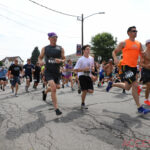“The adrenaline had to be flowing.” — Red Barons manager Bill Dancy
 The date: June 24, 1989
The date: June 24, 1989
The place: Lackawanna County Stadium
The situation: Nearly 8,000 fans at Lackawanna County Stadium were settling in for extra innings. Back in the days of the team’s infancy, the Red Barons were the main draw in town, but they weren’t always offering fans much to cheer about when it comes to results.
When the Red Barons loaded the bases in the bottom of the ninth of a 3-3 game against the Tidewater Tides, manager Bill Dancy made at the time what could be considered a major gamble.
Who knew at the time it would give Red Barons fans their first major reason to celebrate, from a pure baseball sense anyway.
The lead-in: A little less than two months after the Red Barons made their debut in the area, Floyd Rayford emerged as one of the team’s earliest fan favorites.
“Floyd! Floyd! Floyd!” fans would chant as Rayford came to the plate.
Arguably, he had the most notoriety of any player on the Red Barons’ first roster anyway. Seven years earlier, on May 29, 1982, Rayford started the second game of a doubleheader against Toronto for the Baltimore Orioles. He was the third baseman. The next day, Cal Ripken Jr. started, and…he played the next 2,631 consecutive games, pushing himself straight into the history books and the Hall of Fame. Rayford, six years before Ripken broke Lou Gehrig’s streak and more than nine years before the streak ended, was already known in a way as the Wally Pipp of his generation.
He was also a player who had a big major league season under his belt. In 1985 with the Orioles, he hit .306 with 18 homers and 48 RBIs in 105 games, a memory still fresh in baseball fans’ minds when he opened the 1989 season trying to resurrect his career in the Phillies organization.
But the first part of 1989 didn’t go exactly as Rayford or the Phillies wanted. He had been sidelined most of June with back spasms, and he hadn’t batted in three weeks when the Red Barons activated him from the disabled list before the Saturday night clash with Tidewater.
His biggest public contribution to the team in weeks leading up to that night: Rock 107 held a banner contest for fans before the game. Rayford was the judge.
The moment: The Red Barons took an early lead in the second inning.
Traded to the Phillies organization just seven days earlier in a deal that sent former Cy Young Award-winner Steve Bedrosian to the Giants, third baseman Charlie Hayes singled home a run in the second inning, and both Steve Stanicek and Jim Adduci singled and scored in a three-run frame. But the Red Barons offense went silent until the ninth, and the Tides overcame a strong start from Red Barons right-hander Mike Maddux to tie the game in the ninth.
Facing sidewinding right-hander Todd Frohwirth, Jeff McKnight launched a solo homer to tie the score 3-3. In itself, it seemed like a good omen for the Tides. Sent down by the Mets earlier in the day, McKnight was penciled into the Tidewater starting lineup. But, he had to be scratched because he got caught in traffic on Interstate 81 heading to the ballpark before the game.
 The Red Barons, though, had some well-timed magic of their own to unleash. With one on and two out in the bottom of the ninth against Tidewater closer Jack Savage, Mark Ryal delivered a clutch single to put runners on the corners. Stanicek walked to load the bases, with the lefty-swinging Adduci due up. With southpaw Shawn Barton — a former Phillies farmhand who reached Triple-A with the organization in 1987 — called in by manager Mike Cubbage to counteract Adduci, Dancy made his daring call of his own: He summoned the power-hitting Adduci back to the dugout.
The Red Barons, though, had some well-timed magic of their own to unleash. With one on and two out in the bottom of the ninth against Tidewater closer Jack Savage, Mark Ryal delivered a clutch single to put runners on the corners. Stanicek walked to load the bases, with the lefty-swinging Adduci due up. With southpaw Shawn Barton — a former Phillies farmhand who reached Triple-A with the organization in 1987 — called in by manager Mike Cubbage to counteract Adduci, Dancy made his daring call of his own: He summoned the power-hitting Adduci back to the dugout.
And sent Rayford, who hadn’t swung a bat during a game in weeks, to the plate.
“Heck, he’s been taking batting practice off of us,” Dancy said of Rayford. “He’s been getting his swings in, and he’s used to coming to the plate in those types of pressure situations.
“The way Floyd plays in front of this crowd, I wanted him in there.”
Rayford took the first pitch high, but he got a good look at the 1-0 pitch from Barton, driving it high and deep over the left-field wall for a walk-off grand slam. As he crossed the plate, the crowd wildly cheered. Eventually, it coerced Rayford out of the dugout for a curtain call. It was, in many minds, the first big on-field moment in Red Barons history.
HISTORY BEHIND THE MOMENT
 There have been 75 grand slams hit in Scranton/Wilkes-Barre history, but the Rayford slam remains both the only walk-off grand slam the franchise has ever seen, and the only pinch-hit granny of them all.
There have been 75 grand slams hit in Scranton/Wilkes-Barre history, but the Rayford slam remains both the only walk-off grand slam the franchise has ever seen, and the only pinch-hit granny of them all.
Rayford spent part of three seasons with the Red Barons, but he was more coach than player in the final two. In 1990 and 1991, he played a combined 24 games, and he had just 39 career hits with the team when he finally hung up the spikes as a player. But he remained a fan favorite throughout the Red Barons years, which really proved to be more a springboard for his coaching career.
Rayford served as a minor-league coach at varying levels since that 1990 season with the Red Barons through the 2011 campaign, his second as the Rochester Red Wings’ hitting coach. In 1996, he managed the Phillies’ low-Class A entry in the New York-Penn League, the Batavia Clippers. The Clippers went 42-33, and Rayford led several players who would become key members of the Red Barons’ early 2000s teams — infielder Jason Knupfer, outfielder David Francia and pitcher Evan Thomas.
Hayes played only a handful of games with the Red Barons before being called up by the Phillies, but his most famous moment in the big leagues came, of course, as a Yankee. It was Hayes who caught the final out of the Yankees’ improbable 1996 World Series championship, catching Mark Lemke’s foul pop up near the wall along the third-base line at Yankee Stadium to seal the franchise’s 23rd world championship against Atlanta.

Donnie Collins has been a member of The Times-Tribune sports staff for nearly 20 years and has been the Penn State football beat writer for Times-Shamrock Newspapers since 2004. The Penn State Football Blog covers Nittany Lions, Big Ten and big-time college football news from Beaver Stadium to the practice field, the bowl game to National Letter of Intent Signing Day. Contact: dcollins@timesshamrock.com; 570-348-9100 x5368; @DonnieCollinsTT



